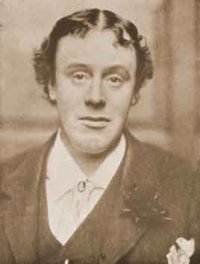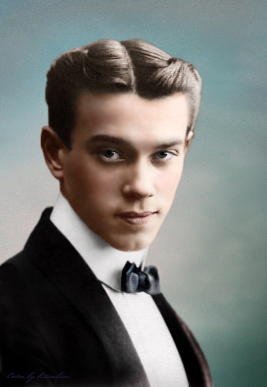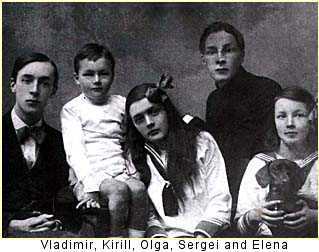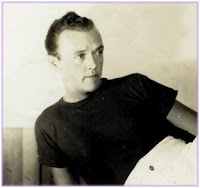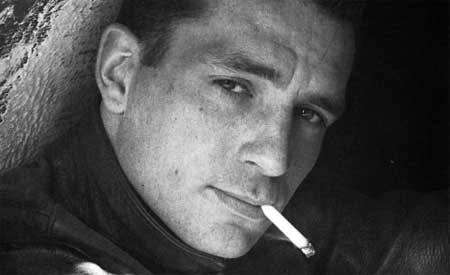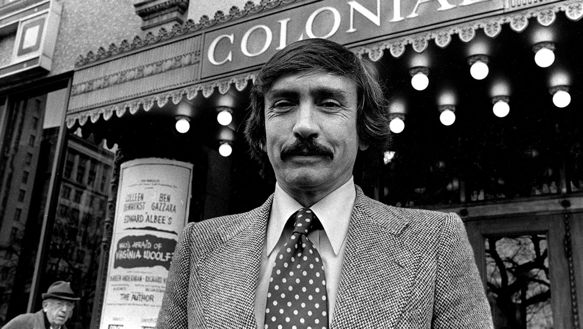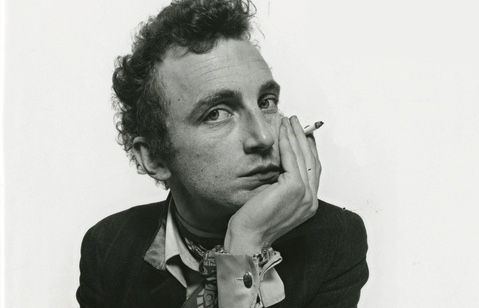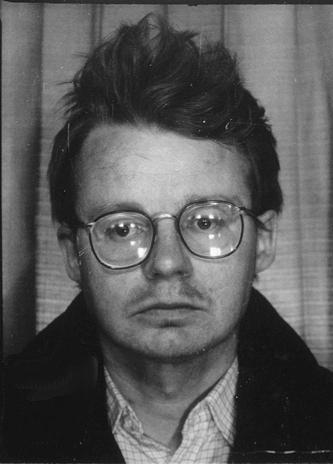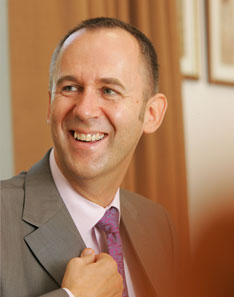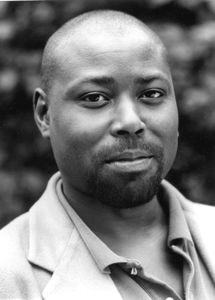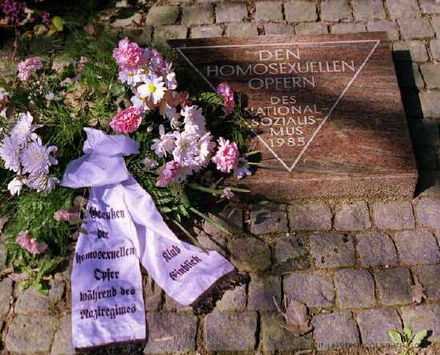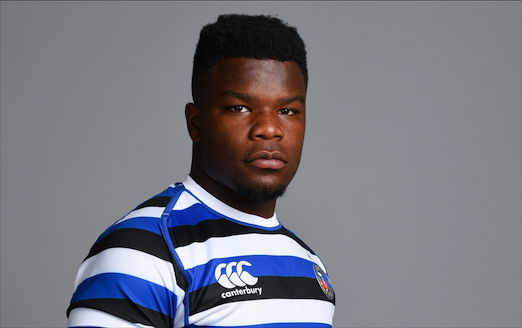|
presents THIS DAY IN GAY HISTORY based on: The White Crane Institute's 'Gay Wisdom', Gay Birthdays, Gay For Today, Famous GLBT, glbt-Gay Encylopedia, Today in Gay History, Wikipedia, and more …
Collected by Ted March 12 [{(o)}]|[{(o)}]|[{(o)}]|[{(o)}]| [{(o)}]|[{(o)}]
1860 – Eric, Count Stenbock, Estonian poet and author of macabre fantastic fiction, born (d.1895); Stenbock's father died suddenly while he was one year old; his properties were held in trust for him by his grandfather Magnus. Eric's maternal grandfather died while Eric was quite young, also, in 1866, leaving him another trust fund. Stenbock attended Balliol College in Oxford but never completed his studies. While at Oxford, Eric was deeply influenced by the homosexual Pre-Raphaelite artist and illustrator Simeon Solomon. He is also said to have had a relationship with the composer and conductor Norman O'Neill and with other "young men". Stenbock behaved eccentrically. He kept snakes, lizards, salamanders and toads in his room, and had a "zoo" in his garden containing a reindeer, a fox, and a bear. When he traveled, he invariably brought with him a dog, a monkey, and a life-sized doll. This doll he referred to as "la Petite Comte" ("the little Count") and told everyone that it was his son; he insisted it be brought to him daily, and—when it was absent—he asked about its health. (Stenbock's family believed an unscrupulous Jesuit had been given large amounts of money by the Count for the "education" of this doll.) One never knew what one would find at this house, where he wrote his opium-induced poems and stories and where he kept a pet toad named Fatima and a lover picked up on a London bus. Visiting Stenbock one day, Oscar Wilde dared to light a cigarette at the votive lamp before the bust of Shelley that his host venerated. This sacrilege caused Stenbock, in true dandy style, to fall to the floor in a dead faint. The unperturbed Wilde, in even truer dandy form, exhaled a puff of smoke, stepped over the prostrate body, and took his leave. Stenbock lived in England most of his life, and wrote his works in the English language. He published a number of books of verse during his lifetime, including Love, Sleep, and Dreams, 1881, and Rue, Myrtle, and Cypress (1883). In 1894, Stenbock published The Shadow of Death, his last volume of verse, and Studies of Death, a collection of short stories that were good enough to be the subject of favorable comment by H.P. Lovecraft.
1890 – An Ohio newspaper publicizes the suicide of a married man who had taken another man he met in a bar back to his hotel room. A letter in his pocket from his wife complains that she hadn't heard from him.
1890 – Vaslav Nijinsky (d.1950); A Russian ballet dancer and choreographer of Polish origin, Nijinsky was one of the most gifted male dancers in history, and he became celebrated for his virtuosity and for the depth and intensity of his characterizations. He could perform en pointe, a rare skill among male dancers at the time and his ability to perform seemingly gravity-defying leaps was legendary. Probably the greatest male ballet dancer of all time, Nijinsky's two greatest achievements, assisted by his impresario lover Sergei Diaghilev, were to bring the role of the male dancer to the fore, and to revitalise a world of classical ballet which had entered a period of decline. Born in Kiev, Ukraine to Polish dancer parents, he was admitted to the St Petersburg Imperial School of Ballet aged 10, where he received an excellent general education as well as a thorough grounding in classical ballet. He was a brillant student and on graduation joined the Imperial Ballet as a soloist in 1907. He had two love affairs with two Russian noblemen, Prince Pavel Dmitrievitch Lvov and Count Tishkievitch but then he met Sergei Diaghilev, a member of the St Petersburg elite and wealthy patron of the arts, promoting Russian visual and musical art abroad, particularly in Paris. Nijinsky and Diaghilev became lovers, and Diaghilev became heavily involved in directing Nijinsky's career. In 1909 Diaghilev took a company to Paris, with Nijinsky and Anna Pavlova as the leads. The show was a great success and increased the reputation of both the leads and Diaghilev throughout the artistic circles of Europe. Diaghilev created Les Ballets Russe in its wake, and with choreographer Michel Fokine, made it one of the most well-known companies of the time. His partnership with Tamara Karsavina, of the Mariinsky Theatre, was legendary.Later, Nijinsky danced again the Mariinsky Theatre, but was dismissed for appearing on- stage wearing tights without the trunks obligatory for male dancers in the company. The Dowager Empress Marie Feodorovna complained that his appearance was obscene, and he was dismissed. It is probable that the scandal was arranged by Diaghilev so Nijinsky could be free to appear with his company, in the west, where many of his projects now centered around him. He danced leading roles in Fokine's new production Le Spectre de la Rose, a role never satisfactorily danced since his retirement, and Igor Stravinsky's Petrushka, in which his impersonation of a dancing but lifeless puppet was much admired. In 1913 he married a young Hungarian woman, Romola Pulszky, who had travelled throughout Europe in pursuit of her dieu de la danse, whilst on tour in Buenos Aires. Devastated by his betrayal, Diaghilev dismissed his star from the company leaving Nijinsky stranded with wife and child and no career - furthermore, it was the First World War and Nijinsky was a Russian citizen in Hungary, and technically a prisoner of war. Diaghilev attempted a reconciliation with Nijinsky, inviting him to rejoin the Ballet Russes on more than one occasion, but relations between the two former lovers and Nijinsky's wife frustrated every attempt to recreate his former success. In the later years of the First World War signs of Nijinsky's mental illness became increasingly obvious to his wife and colleagues. In 1919 he suffered a mental breakdown. Increasingly unhappy with his marriage, his ruined career, and a world in turmoil, Romola committed him to a mental institution where he was diagnosed with schizophrenia and subjected to years of drugs and experimental shock treatment. He became a broken man and spent the rest of his life drifting between institutions, even having to be rescued from one asylum when the Nazis began to inter the mentally ill. He died in London in 1950. 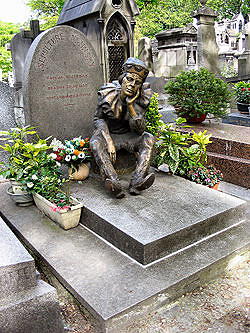 Nijinsky's Grave, Montmartre Cemetary, Paris Of the thousands of descriptions of the famous dancer, only Cocteau's suggests the "mortal god" that was Nijinsky. Cocteau alone observed
"the contrast
between the Nijinsky of Le Spectre de la Rose, bowing and smiling to thunderous
cheers as he took his fifty curtain calls, and the poor athlete backstage between
bows, gasping and leaning against any support he could find, half fainting,
clutching his side, being given his shower and massage and rubdown by his
attendance and the rest of us. On one side of the curtain he was a marvel of
grace, on the other, an extraordinary example of strength and weakness..."
1900 – Sergei Nabokov (d.1945), brother of Russian author Vladimir Nabokov, was born in St. Petersburg. The Nabokovs were members of imperial Russia's most exclusive social circles. The family was extraordinarily wealthy; their lineage included princes and generals and government ministers, and even their faithful dog, Box II, was descended from a pair that belonged to Anton Chekhov. While Vladimir was the eldest and the center of attention, Sergei grew up out of the limelight, shy and unhappy and somewhat odd. Sergei was afflicted with an atrocious stutter that would only get worse as he got older. He idolized Napoleon and slept with a bronze bust of him in his bed. He also loved music, particularly Richard Wagner, and he studied the piano seriously. 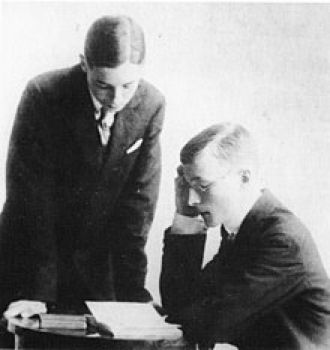 Vladimir and Sergei Nabokov When he was 15 and Vladimir 16, Vladimir found Sergei's diary open on his desk and read it. He showed it to their tutor, who showed it to the children's father. It was proof of his blossoming sexuality. His homosexuality was behind Sergei's withdrawal from the famously progressive Tenishev school, an all-boy private school also attended by Vladimir and by poet Osip Mandelstam. Sergei left because of a series of "unhappy romances," about which his family instituted a kind of "don't ask, don't tell" policy. When the revolution came in 1917, the Nabokov family fled Russia, barely escaping with a fraction of their fortune on a Greek cargo boat loaded with dried fruit. Neither Vladimir nor Sergei would ever return to his motherland. After brief stops in Athens and Paris, Vladimir wound up enrolled at Cambridge University; Sergei started at Oxford but joined his brother at Cambridge a semester later, where they both earned degrees. When the brothers graduated in 1922, they joined their family in Berlin, which had become the social and cultural center of the Russian diaspora. Sergei fit easily into the growing gay community there, and he was friendly with German activist Magnus Hirschfeld, founder of the world's first gay tolerance organization. Sergei and Vladimir went to work at a bank, but the 9-to-5 routine didn't suit them: Sergei quit after a week, Vladimir in a matter of hours. Vladimir remained in Berlin, where he met and married his wife, Vira, but Sergei moved on to Paris. In the Paris in the '20s, Sergei most likely felt at home for the first time in a city that celebrated art and music, and that took his gayness in stride. In the winter of 1923 he met painter Pavel Tchelitchev, whose work now hangs in New York's Museum of Modern Art and who painted sets for Sergei Diaghilev. Tchelitchev was also gay and also a Russian imigri, and the two of them shared an apartment with Tchelitchev's lover, Allen Tanner. The flat was tiny. It had no electricity and no bath — they had to wash themselves in a zinc tub using water heated on a gas stove. Sergei survived by giving lessons in English and Russian.But the cultural scene in which Sergei found himself was rich. Sergei became good friends with Jean Cocteau, and he was also connected, through Tchelitchev, and his cousin Nicolas Nabokov, to Diaghilev, to composer Virgil Thomson, to the Sitwells and even to the legendary salons conducted by Gertrude Stein and Alice B. Toklas. The story of Sergei's life in Paris has a Cinderella ending. Sometime in the late '20s or early '30s he met and fell in love with a wealthy, aristocratic Austrian, Hermann Thieme. Charming, handsome, something of a dilettante, Thieme was the son of an insurance magnate. His family owned (and still owns) Schloss Weissenstein, a magnificent 12th century castle in the tiny Alpine village of Matrei im Osttirol near Innsbruck, Austria. During the '30s Hermann and Sergei often retreated to Schloss Weissenstein. In the spring of 1940 Hitler invaded France, and by May the Germans were bombing Paris. Vladimir and his family left for America on the last boat out of St. Nazaire, but Sergei was away in the countryside at the time. He returned to Paris to find the family apartment suddenly empty. He chose to stay in Europe with Hermann. The Nazis were already rounding up homosexuals as actively as they were Jews, and to avoid attracting suspicion Sergei and Hermann saw each other only rarely. Sergei took a job as a translator in Berlin, but he had no stomach for war, and the Allied bombings frightened him horribly. The fighting grew more intense, and flight became impossible; Sergei had almost no money, and as a refugee from czarist Russia his only travel document was a flimsy Nansen passport. In 1941 the Gestapo arrested Sergei on charges of homosexuality. It released him four months later, but he was placed under constant surveillance. It's ironic that at that moment, after a lifetime of shyness and stuttering, Sergei could not keep silent. He began to speak out vehemently against the injustices of the Third Reich to his friends and colleagues.Three weeks later he was arrested for the second time. An old Russian acquaintance asserts that asserts that Sergei was in fact involved in a plot to hide an escaped prisoner of war, a former Cambridge friend who had become a pilot and been shot down over Germany. After his arrest Sergei was taken to Neuengamme, a large labor camp near Hamburg, where he became prisoner No. 28631. Conditions were brutal: The camp was a center for medical experimentation, and the Nazis used the prisoners to conduct research on tuberculosis. Of the approximately 106,000 inmates who passed through Neuengamme, fewer than half survived, and as a rule, the guards singled out homosexuals for particularly harsh treatment. Sergei's conduct in the camp was nothing less than heroic. Ivan, son of Sergei's composer cousin Nicolas Nabokov, says that after the war, survivors from Neuengamme would telephone his family out of the blue — they were the only Nabokovs in the book — just to talk about Sergei. "They said he was extraordinary. He gave away lots of packages he was getting, of clothes and food, to people who were really suffering." Meanwhile, Hermann had also been arrested, but he was sent to fight on the front lines in Africa. He would survive. He spent his later life at Schloss Weissenstein, without a career, caring for his invalid sister. He died in 1972. In the early fall of 1945, in his apartment in Cambridge, Mass., Nabokov dreamed of his brother Sergei. He saw him lying on a bunk in a German concentration camp, in terrible pain. The next day he received a letter from a family member in Prague. According to camp records, "Sergej Nabokoff" had died on Jan. 9, 1945, of a combination of dysentery, starvation and exhaustion. Neuengamme was liberated four months later.
1906 – Bruz Fletcher was an American singer, songwriter and novelist who enjoyed brief success during the so-called Pansy Craze in the 1930s. (d.1941) Singer, composer, novelist, and playwright, the darling of sophisticated night spots in the 1930s, he left behind three albums of complex coded songs and two novels. His drama-filled life was a sad story of extremes and incredible plot twists. One of his more risqué recordings was called "My Doctor" (1935). His signature song "Drunk with Love" was daringly adopted by Frances Faye and became a standard in gay bars for decades to follow. As a songwriter he was a master of writing coded lyrics concealing a queer undercurrent. He became a master of gay code and double speak in order to survive and flourish in a very homophobic era. After a successful career as a songwriter and nightclub performer in Hollywood in the 1930s the police began a clampdown on gay performers and venues which made it increasingly difficult for Bruz Fletcher and similar artists to find work or perform; it is widely believed that this frustration contributed to Fletcher's suicide in 1941. He left behind a catalogue of intelligent and witty songs and a few records. There is an excellent detailed biography of Bruz Fletcher, his life and career at the Bruz Fletcher Project. (Link below) Here is Frances Fay singing Fletcher's Drunk With Love
1922 – Jack Kerouac, (d.1969); bisexual American novelist, writer, poet and artist. Along with William S. Burroughs and Allen Ginsberg, he is amongst the best known of the writers (and friends) known as the Beat Generation. Kerouac's work was popular, but received little critical acclaim during his lifetime. Today, he is considered an important and influential writer who inspired others, including Tom Robbins, Lester Bangs, Richard Brautigan and Ken Kesey, and writers of the New Journalism. Kerouac also influenced musicians such as The Beatles, Bob Dylan, Morrissey, Tom Waits, Simon & Garfunkel, Lebris, Ulf Lundell and Jim Morrison. Kerouac's best-known books are On The Road, The Dharma Bums, Big Sur and Visions of Cody. Kerouac, born Jean-Louis Kerouac in Lowell, Massachusetts,was the third child of a working-class, French-Canadian family. Kerouac did not speak English until attending parochial school at the age of six, the French-Canadian dialect Joual being his primary language. 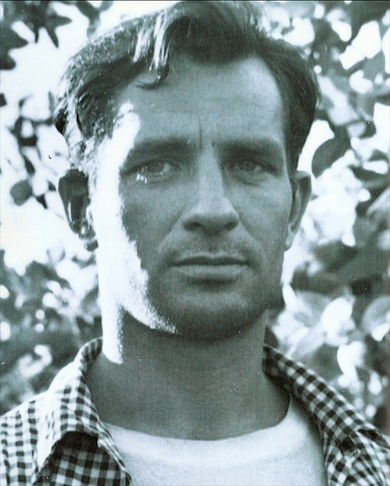 As a young man, he enlisted in the U.S. Navy but was discharged on psychiatric grounds. Through his first wife, Edie Parker, Kerouac met Allen Ginsberg and William Burroughs in 1944. In 1946, Neal Cassady became involved with their group, and the nucleus of the Beat Generation was created. It was with Cassady that Kerouac took to the road. Though many of his poet and artist friends, including Cassady and Ginsberg, were gay, Kerouac, in his correspondence and journals, considered homosexuality to be a fault, a sin, a vice. In On the Road, Sal's friend Carlo Marx, based on Ginsberg, is openly gay. Kerouac, himself, was bisexual, but in denial. He exchanged letters with Alan Ginsberg in an attempt to clarify for himself the nature of his sexuality. It appears that he may have had some gay encounters with Neal Cassady on their travels together (In Visions of Cody he waxes rhapsodic about everything from the size of Cassady's penis to how much he thought about his best friend.), but he generally detested homosexuals.This kind of hatred of gays by some gay or bisexual men is not uncommon, and may be a way for them to compensate for feelings of guilt or inadequacy. On the other hand, at that time homosexuality was not an open subject. If he were writing today, he might still be as sexually conflicted as he was in life, but he would have had a richer public context in which to view his conflicts. Kerouac's Catholic guilt made lasting relationships with men impossible, as evidenced by his casual attitude toward his male sex partners - among whom were Allen Ginsberg, William Burroughs, Alan Ansen and Gore Vidal. (Kerouac, Vidal bragged in print later, was the bottom that night). Kerouac's uneasiness toward his homosexuality led to his practice of omitting his homosexual experiences from his books. For example, The Subterraneans (1958) alters his real-life affair with Gore Vidal into a platonic night spent in a hotel room. Despite this reticence and ambivalence, many of his early works authentically depict gay culture at a time when such portrayals were rare in popular literature. He died in 1969, from complications of alcoholism.
1928 – The American playwright Edward Albee (d.2016) was born in Washington, DC, as Edward Ranklin Albee III. He is best known for his plays Who's Afraid of Virginia Woolf?, The Zoo Story, A Delicate Balance and Three Tall Women. His works are considered well-crafted, often unsympathetic examinations of the modern condition. His early works reflect a mastery and Americanization of the Theatre of the Absurd that found its peak in works by European playwrights such as Jean Genet, Samuel Beckett, and Eugène Ionesco. Younger American playwrights, such as Pulitzer Prize-winner Paula Vogel, credit Albee's daring mix of theatricalism and biting dialogue with helping to reinvent the post-war American theatre in the early 1960s. Albee continued to experiment in newer works, such as The Goat: or Who Is Sylvia? (2002). His early off-Broadway work was, for its time, daring in his mention of homosexuality and its implied homoeroticism. The Zoo Story is a Central Park confrontation between Peter, an ineffectual wealthy man, and Jerry, a counter-cultural figure intent on telling his life story and driving someone to kill him. Jerry's world is the zoo of the title, a brutal universe in which God is "a colored queen in a kimono," indifferently filing his nails. The American dream is a scantily clad, beautiful but heartless male hustler. Yet Albee's homosexuality and the gay subtext of his early work came to haunt him. Some heterosexist critics, angered by Albee's scathing picture of modern marriage in Who's Afraid of Virginia Woolf, insisted that George and Martha, the feuding central couple in the play had to be a thinly-disguised gay couple By this time, leading New York critics were becoming increasingly hostile toward the more openly gay work of Williams, William Inge, and Albee. When Albee's allegorical Tiny Alice, in which a cardinal and a lawyer are bickering ex-lovers, opened in 1964, critics attacked furiously. There is always a hint of the homoerotic about his male-male confrontations. Conventional heterosexual marriage, which is always depicted as infertile, and heterosexual all-American boy-men are his favorite targets. However, Albee saw himself as a satirist of the American condition and not a dramatist of the gay community. As a playwright who staked his success on Broadway in the 1960s and 1970s, he had no choice. However, his critics, though seldom fair, were partly right: It is impossible to ignore the far-from-gay homosexuality in Albee's plays. Albee was openly gay and stated that he first knew he was gay at age 12 and a half. Albee was briefly engaged to Larchmont debutante Delphine Weissinger, and although their relationship ended when she moved to England, he remained a close friend of the Weissinger family. Growing up, he often spent more of his time in the Weissinger household than he did in his own, due to discord with his adoptive parents. Albee insisted that he did not want to be known as a "gay writer", stating in his acceptance speech for the 2011 Lambda Literary Foundation's Pioneer Award for Lifetime Achievement: "A writer who happens to be gay or lesbian must be able to transcend self. I am not a gay writer. I am a writer who happens to be gay." His longtime partner, Jonathan Thomas, a sculptor, died on May 2, 2005, from bladder cancer. They had been partners from 1971 until Thomas's death. Albee also had a relationship of several years with playwright Terrence McNally during the 1950s. Albee died at his Montauk, New York, home on September 16, 2016, aged 88.
1936 – Patrick Procktor (d.2003) was a prominent English artist of the late 20th century. Patrick Procktor was born in Dublin, the younger son of an oil company accountant, but moved to London when his father died in 1940. From the age of 10, he attended Highgate School – where his teachers included landscape painter Kyffin Williams – intending to read classics at university. However, his mother's income was insufficient to fund his further education and after a period working with a north London builders' merchants 18-year-old Procktor was conscripted into the Royal Navy where, during his National Service, he learned to speak Russian Subsequently, while working as a Russian interpreter with the British Council, Procktor began to paint and draw in his spare time, and was accepted by the Slade School of Fine Art in 1958. There he was influenced by artists including William Coldstream and Keith Vaughan, developing a dark, figurative painting style. In 1962 he became a professional artist and had his first show at the Redfern Gallery in London's Cork Street in 1963 – a great commercial success that helped confirm his reputation among a wider artistic circle including the theatre and music (he won numerous commissions for pop record sleeves). A year later, Procktor was featured in Bryan Robertson's New Generation exhibition at the Whitechapel Gallery – a show that also raised the profile of fellow artists David Hockney, Bridget Riley and John Hoyland. Procktor's work, primarily in oils, acrylics and watercolour, drew on pop art influences, but was also influenced by his travels (he visited Italy, Greece, India, China and Japan, among other places). He was also adept at print-making, producing a sequence to illustrate a new 1976 edition of Coleridge's The Rime of the Ancient Mariner. In 1984 he was commissioned to paint a reredos for the St John the Baptist's Chapel in Chichester Cathedral. His model for the various figures of St John was his friend, photographer David Gwinnutt. Procktor's painting The Guardian Readers was used as the cover art for Elton John's 1976 album, Blue Moves. Procktor was elected a member of the Royal Academy in 1996 and died seven years later, aged 67. Procktor lived in Manchester Street, Marylebone, central London (in a flat formerly occupied by William Coldstream), where he socialised with, among others, Derek Jarman, Francis Bacon, and Cecil Beaton (several of Beaton's photographs of Procktor are in the National Portrait Gallery; Procktor's own 1967 pen and ink drawing of Joe Orton is also in the Gallery's collection). He dressed exotically and, like Hockney, flaunted his homosexual preferences; unlike Hockney, this was to the detriment of his sales from at least one exhibition, in 1968 in New York, which he devoted to paintings of his lover at the time, Gervase Griffiths. It was a one-man show which Procktor insisted on calling a one-boy show. Its failure, though, was probably more a comment on an uncharacteristic lack of variety than an expression of homophobia. Despite his homosexual leanings, in 1973 Procktor married a widow neighbour and restaurateur Kirsten Benson. She sold her restaurant (Odin's) to Peter Langan, and Procktor, Hockney, Bacon and Lucian Freud all provided paintings to hang on the walls of Odin's and Langan's Brasserie in return for hospitality. He appeared, as himself, in the 1974 Hockney biopic, A Bigger Splash.
1947 – Hugo Kalervo Palsa (d.1987), or Kalle was a Finnish artist in a style that has been described as fantastic realism. Long neglected, Kalervo Palsa has enjoyed a revival of sorts since the publication of critical works, a biography and two major retrospectives in Helsinki and Pori. Among his local contemporaries of Kittilä in Lapland he had the reputation of a drunken artist masturbating at home and painting furiously. He is said to have felt haunted both by his perverse urges and the provincial and narrow-minded mental perimeter of his northern hometown. While he lived there, his abode was a tiny studio cabin which was closer to a shack than a house. He wired it for electricity by drawing a long extension cable from a nearby house. He called it his "Getsemane" after the biblical site, or sometimes his "castle in the clouds". Upon his death from pneumonia, two rumours spread in the local community. One that he had in a drunken stupor collapsed into a snowbank, and died from exposure. The other that he had hanged himself. The latter was more understandable, since several of his self-portraits featured a hangman's noose around his neck, and several other of his paintings also used the symbology of hanging. 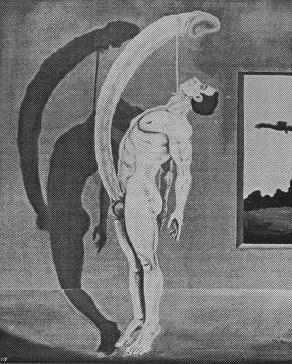 Deliverance Kalervo Palsa used an incredibly varied palette of techniques and materials even including housepaint. The subjects with the richest content, generally received the most hurried and crude treatment. The over 1000 self-portraits on the other hand generally were treated at the very least with competent technique. 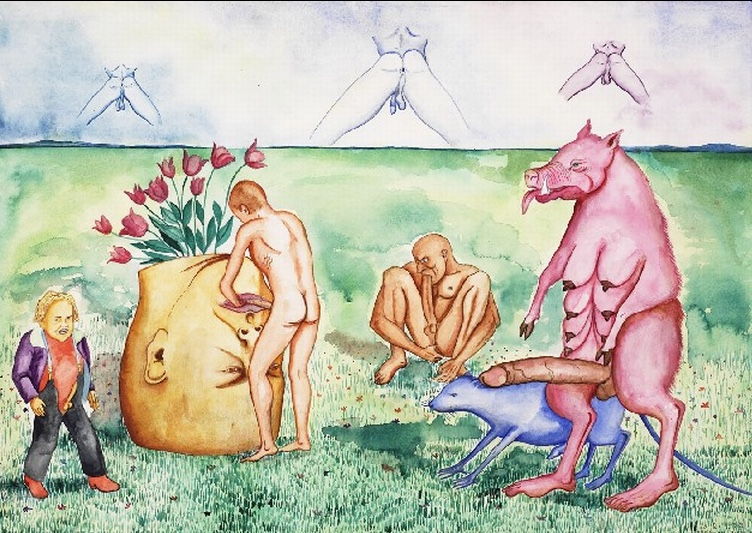 Finlandia (Click for larger) Mostly the works explore in graphic detail the dark side of humanity in general and his native northern regions specifically. Grotesque sexuality, sadism, homosexuality, bisexuality and a general emotional frigidity paraphilia reflect his own inner turmoil and were perhaps a reaction to the mental atmosphere of his hometown. His work has been compared to that of Hieronymous Bosch.
1963 – James Clark, British diplomat, was, for a time, Consul General at Chicago, and was previously British Ambassador to Luxembourg. Clark's appointment as British Ambassador to Luxembourg in March 2004 was heralded with some small controversy, due largely to his being openly gay. On 30 March 2004, he and his partner Anthony Stewart made history by becoming the first officially recognised gay couple to have an audience with Queen Elizabeth II.
1963 – Randall Kenan is an American author of fiction and nonfiction. Raised in a rural community in North Carolina, Kenan has focused his fiction on what it means to be black and gay in the southern United States. Kenan was born in Brooklyn, New York. Initially raised by his grandparents, Kenan soon went to live with a great-aunt in Chinquapin, North Carolina, a rural community of fewer than a thousand people. The community later became the basis of the fictional Tims Creek, where all of Kenan's fiction is set. Kenan's first novel, A Visitation of Spirits, was published in 1989. While a few critics praised the book, it did not receive much attention. This changed with the publication in 1992 of Kenan's second book, a collection of short stories titled Let the Dead Bury Their Dead. The stories, based in the fictional community of Tims Creek, focused on (among other things) what it meant to be poor, black, and gay in the southern United States. The book was hailed as a revival of classic southern literature and was nominated for the Los Angeles Times Book Award for Fiction, was a finalist for the National Book Critics Circle Award, and was named a New York Times Notable Book. The short story collection also brought renewed attention to his first novel, which was likewise set in Tims Creek. Kenan strongly identifies with both his African American and gay identities, both of which were highlighted in his next two books. In 1993 he published a young adult biography of gay African American novelist and essayist James Baldwin. Kenan has frequently stated that Baldwin is one of his idols. He then spent several years traveling across America and Canada collecting oral histories of African Americans, which he published in Walking on Water: Black American Lives at the Turn of the Twenty-first Century (1999).
1965 – The Minnesota Supreme Court rejects intoxication as a sodomy defense
1994 – The Church Of England ordains its first female priests and Conservatives are still whining about it..
1985 – On this date the first memorial to the Nazi's Gay victims was unveiled: a pink granite stone monument at the former Neuengamme concentration camp, inscribed "Dedicated to the Homosexual victims of National Socialism."
1998 – Levi Davis is an explosive winger with an eye for the whitewash and is a former England U18s and U19s international. Davis was a regular in the Bath United team in the 2017 season and scored on his first team debut in the 26-22 victory against London Irish in November 2017. Davis started the 2019/20 campaign in a rich vein of form, scoring three times in as many games in the Premiership Rugby Cup, with Anthony Watson, Ruaridh McConnochie and Joe Cokanasiga away with England at the Rugby World Cup and Semesa Rokoduguni injured at that point of the season. In January 2020 he signed a loan deal with Championship side Ealing Trailfinders. He went to the same school, The Friary in Lichfield, as Daniel Sturridge and was involved in the Wolverhampton Wanderers Academy, but he was 'scouted' for rugby aged 12 when spotted chasing someone who had stolen his cap.  Levi on X-Factor A talented musician, Levi appeared on Celebrity X-Factor in 2019 as part of rugby boy band Try Star with Thom Evans and Ben Foden. But in April 2020, in the midst of lockdown, every Bath Rugby player received a WhatsApp message they weren't expecting. The message from Levi read: 'Hi guys. I just want to tell you something that's been eating away at me for four years now. I want to be open and honest with you boys, as friends and team-mates. I'm bisexual. It's something I have known since I was 18.'Jokingly he signed off, 'None of you lot are on my radar... so it's OK'. What happened next brought an overwhelming rush of relief to the former England U18s and U19s player as the supportive messages from his team mates quickly buzzed into his inbox. 'Mate, we support you.' Davis, who joined highly ambitious Championship side Ealing Trailfinders over the summer, has praised his former Gallagher Premiership club Bath for supporting him over the last year as his mental health suffered and he turned to heavy drinking as he wrestled with his secret.
[{(o)}]|[{(o)}]|[{(o)}]|[{(o)}]| [{(o)}]|[{(o)}] |
